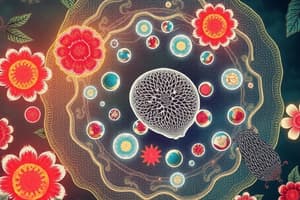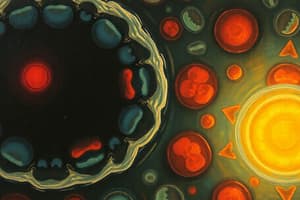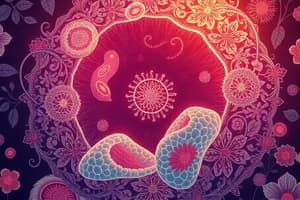Podcast
Questions and Answers
What is the primary function of the mitochondria?
What is the primary function of the mitochondria?
- Protein synthesis
- Cell division
- ATP production (correct)
- Photosynthesis
Chloroplasts are found in both plant and animal cells.
Chloroplasts are found in both plant and animal cells.
False (B)
Name one unique organelle found in animal cells.
Name one unique organelle found in animal cells.
Lysosomes
The _______ maintains turgor pressure in plant cells.
The _______ maintains turgor pressure in plant cells.
Match the organelles to their functions:
Match the organelles to their functions:
Which organelle is responsible for detoxification in cells?
Which organelle is responsible for detoxification in cells?
Centrioles are primarily involved in photosynthesis.
Centrioles are primarily involved in photosynthesis.
What is the main component of the plant cell wall?
What is the main component of the plant cell wall?
Flashcards are hidden until you start studying
Study Notes
Organelles of Plant Cell and Animal Cell
Common Organelles in Both Plant and Animal Cells:
-
Nucleus
- Contains genetic material (DNA).
- Controls cellular activities.
-
Ribosomes
- Sites of protein synthesis.
- Can be free in cytoplasm or bound to the endoplasmic reticulum.
-
Endoplasmic Reticulum (ER)
- Rough ER: Studded with ribosomes; involved in protein synthesis and processing.
- Smooth ER: Lacks ribosomes; involved in lipid synthesis and detoxification.
-
Golgi Apparatus
- Modifies, sorts, and packages proteins and lipids for secretion or delivery to other organelles.
-
Mitochondria
- Powerhouse of the cell; site of ATP (energy) production through cellular respiration.
-
Cytoskeleton
- Network of fibers (microfilaments, intermediate filaments, microtubules) providing structure and shape.
- Involved in cell movement and transport of materials.
Unique Organelles in Plant Cells:
-
Chloroplasts
- Site of photosynthesis; contains chlorophyll.
- Converts sunlight energy into chemical energy (glucose).
-
Cell Wall
- Rigid outer layer providing structure and protection.
- Composed mainly of cellulose.
-
Central Vacuole
- Large storage sac; maintains turgor pressure for cell rigidity.
- Stores nutrients and waste products.
Unique Organelles in Animal Cells:
-
Lysosomes
- Contains digestive enzymes.
- Breaks down waste materials and cellular debris.
-
Centrioles
- Involved in cell division; helps organize the mitotic spindle.
- Typically found in pairs.
-
Cilia and Flagella
- Hair-like structures used for movement.
- Cilia are short and numerous; flagella are longer and fewer.
Summary:
- Both plant and animal cells share several organelles, ensuring essential life processes.
- Plant cells are distinctly characterized by chloroplasts, a rigid cell wall, and a large central vacuole, whereas animal cells possess lysosomes and centrioles, which assist in digestion and cell division, respectively.
Common Organelles
- Nucleus: Contains DNA, controls cellular activities.
- Ribosomes: Sites of protein synthesis. Found free in cytoplasm or bound to ER.
- Endoplasmic Reticulum (ER):
- Rough ER: Studded with ribosomes, involved in protein synthesis and processing.
- Smooth ER: Lacks ribosomes, involved in lipid synthesis and detoxification.
- Golgi Apparatus: Modifies, sorts, and packages proteins and lipids for secretion or delivery to other organelles.
- Mitochondria: Site of ATP (energy) production through cellular respiration. Considered the "powerhouse" of the cell.
- Cytoskeleton: Network of fibers (microfilaments, intermediate filaments, microtubules) providing structure and shape. Involved in cell movement and transport of materials.
Plant Cell Unique Organelles
- Chloroplasts: Site of photosynthesis; contains chlorophyll. Converts sunlight energy into chemical energy (glucose).
- Cell Wall: Rigid outer layer providing structure and protection. Composed mainly of cellulose.
- Central Vacuole: Large storage sac. Maintains turgor pressure for cell rigidity. Stores nutrients and waste products.
Animal Cell Unique Organelles
- Lysosomes: Contain digestive enzymes. Break down waste materials and cellular debris.
- Centrioles: Involved in cell division; helps organize the mitotic spindle. Typically found in pairs.
- Cilia and Flagella: Hair-like structures used for movement. Cilia are short and numerous; flagella are longer and fewer.
Studying That Suits You
Use AI to generate personalized quizzes and flashcards to suit your learning preferences.





